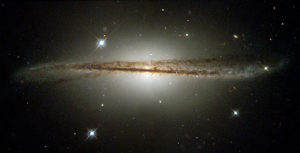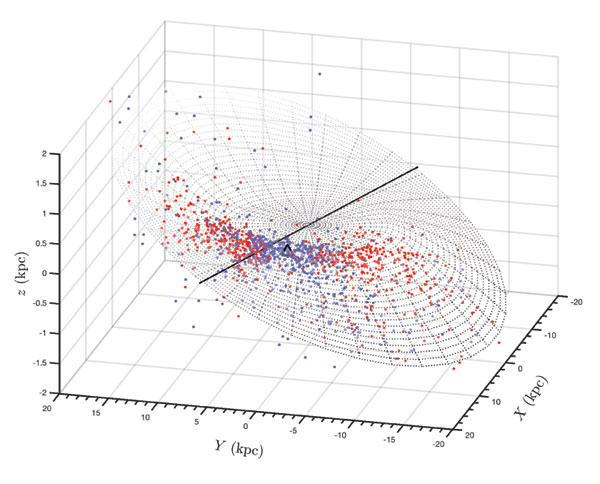Astronomers mapping out luminous stars across our galaxy's disk found that the Milky Way is warped — and multiple factors are twisting its shape.
Picture a spiral galaxy and you probably see something like most artist illustrations of the Milky Way: a top-down view of a pinwheel. But from the side, these disk galaxies appear drastically different. For one, they’re much thinner than they are wide — the typical aspect ratio is like that of a pancake. And, like pancakes wobbling as they flip through the air, these galaxies are often warped.

Hubble Heritage Team (STScI / AURA) / C. Conselice (U. Wisconsin / STScI) et al. / NASA
In 1957 radio observations first revealed a warp in the Milky Way’s disk of hydrogen gas, its reservoir of star-making materials. Since then astronomers have seen hints of this warp in other sources, including galactic pulsars, neighborhood stars, and even in the cosmic dust floating throughout our galaxy.
Now, Xiaodian Chen (Chinese Academy of Sciences) and his colleagues have pinpointed luminous stars across two-thirds of our galaxy’s stellar disk, mapping out its warp in exquisite detail. The results, which appear in Nature Astronomy, can help us figure out how our galaxy got its shape.
Spiral with a Twist
Three years ago Chen set out looking for variable stars known as Cepheids. Cepheids are giant stars that can have 20 times the mass of the Sun and 100,000 times its brightness. They become unstable as they near the end of their lives, pulsating in a way that ties directly to their luminosity. That trick makes them invaluable to astronomers, who can use them as objective measures of distance. For this reason, astronomers are always seeking more of them.
Because Cepheids are the kind of massive, fast-burning stars likely to be found in sites of recent star formation, Chen was originally hoping to map out the spiral structure of the Milky Way. But as he plotted the locations of thousands of Cepheids, he realized it wasn’t the spiral arms he was seeing but the warp of our galaxy’s stellar disk.
At least half of all galaxies are warped, but what’s twisting them remains unclear. Twisted shapes may arise during gravitational interactions with satellite galaxies: the Magellanic Clouds, for example, are close enough that they could warp our galaxy’s disk. The infall of other dwarf galaxies long ago — now seen as streams of stars flitting around and out of the disk — could also have played a role. Other options include intergalactic magnetic fields, an interstellar wind blown by starbirth and death, or a misalignment between our galaxy’s disk and the much larger halo that surrounds it.
In other words, the problem is not the lack of possible explanations — it’s the lack of data.
Mapping the Milky Way
Chen picked out 1,339 Cepheid variable stars from the Widefield Infrared Survey Explorer (WISE) catalog and a number of visible-light surveys. While lots of Cepheids can be found by their visible light, infrared light enables astronomers to peer through dust into places like star-forming regions.

X. Chen et al., Nature Astronomy, 2019 Feb 4.
The stars trace a warped disk that extends 65,000 light-years from the galaxy’s center. (The Sun, for reference, is 26,000 light-years out.) The shape is like thrown pottery gone wrong — one side wings upward while the other splays asymmetrically downward. Because the stars’ distances are known so well, Chen and colleagues can precisely replicate the shape they trace using a mathematical model.
Analyzing the model, the researchers suggest that multiple pulls and pushes maintain our galaxy’s shape. Within 50,000 light-years of our galaxy’s center (in other words, within the main portion of the Milky Way), the inner stellar disk pulls on and distorts the outer disk as they both turn in their orbits. But at greater distances from the center, there’s something else at play: “most likely accreted dwarf galaxies or misaligned angular momentum of disk and halo,” Chen says.
The current map shows stars mostly on our side of the galaxy, but infrared surveys continue to find Cepheids on the far side of the Milky Way. Eventually, astronomers will be able to map out the whole of the disk for better insight into not only on its structure but also its history.
 1
1









Comments
TorbjornLarsson
February 7, 2019 at 5:56 am
I had to catch up on this, but I see that perhaps 50 % of spirals are warped and that the Local Group spirals are mostly warped. Else the 20 % warp offset looks huge (but the comparison image here helps).
I seem to remember an observation of MW wobbles on a much smaller scale in the old (null model, I guess) flat reference system, indicating a recent passing by or through by a dwarf galaxy. It would be cool to see these effects added up and integrated into the "push and pull" mess of our galaxy. Also, density wave (?) spiral arms must be a robust phenomena!
You must be logged in to post a comment.
You must be logged in to post a comment.